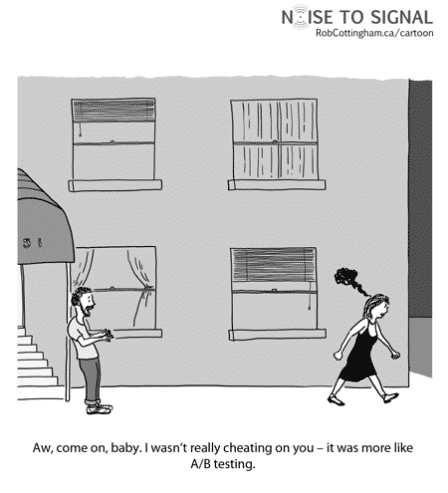Why Your Website Isn’t Converting the Way You Want It To
by Jacob Baadsgaard • September 17, 2015
So, you’re driving traffic to your website. More than that, you’re actually driving the right sort of traffic to your site. For all intents and purposes, you’re running a brilliant marketing campaign.
Problem is, your traffic isn’t turning into sales.
You’ve tried tweaking everything from an advertising standpoint—changing ad copy and keywords, setting up remarketing and running social media campaigns—and still, nothing.
Maybe you’ve seen a small increase in conversions; but, for all the effort you’re putting into your online marketing, you aren’t getting much of a return.
What the heck is going on?

Traffic Is Not Enough
Unfortunately, traffic—even the right traffic—isn’t enough to make your advertising efforts profitable. You need people to buy your product, fill out your form or give you a call.
In other words, you need people to convert.
The problem is, simply sending people who should convert (that right sort of traffic you worked so hard to get to your site) to your website doesn’t mean that they will convert.
Yeah, they probably should convert; but, if your website isn’t set up right, they’ll leave without realizing how badly they want what you’ve got.
How to Turn Traffic Into Profit
Getting your target audience to your website is only half the battle. To get your traffic to convert, your website has to finish the job. This is where conversion rate optimization comes into play.
Conversion rate optimization (CRO) is the process of optimizing your landing page and website to—you guessed it—produce more conversions from your traffic!
The great thing about CRO is that it helps you get the most out of the traffic that you already have. For example, even without increasing traffic to your site, improving your conversion rate from 1% to 2% will double your conversions.
In other words, you can dramatically increase your sales without driving any more traffic to your site!

Can you see why CRO is such an important part of your online marketing strategy? If you’re not doing CRO, you are wasting money.
So, how do you get at all those lost conversions? It’s not as difficult as you might think.
Here are a few ways to start doing CRO today:
1. Create a Dedicated Landing Page
If you are doing any sort of paid advertising (AdWords, Bing Ads, etc), you should be sending your traffic to a dedicated landing page.
There are so many good reasons to do this, but the biggest reason is page optimization. If you’re going to pay to get traffic to your site, you want to send them to a page that is designed to sell.
Landing pages are also the easiest type of page to do CRO on; so, if you’re still sending your traffic to your homepage, this is the first place I’d start.
If you need some help, you can find a quick guide to setting up a high-converting landing page here.
2. Come Up With a Hypothesis
All good CRO tests start with a hypothesis. But, to put your hypothesis together, you’ll have to make some educated guesses about which site elements have the biggest impact on your conversion rate and profitability.
Here are a few areas you can look at first:
- Headline. Your headline needs to sell and sell hard. 80% of your audience won’t get past your headline, so—even if you don’t optimize anything else—you should at least test your headline.
- Offer. Your audience isn’t you, so they don’t always respond the way you think they will. Try different descriptions and layouts to see what resonates best with your prospective clients.
- Call-to-action. Like your offer, the right call-to-action (CTA) may take a few variants to discover. Test more descriptive CTAs or different button sizes.
- Media. Sometimes a new picture or video can make all the difference.
Once you’ve got a hypothesis and two page designs to assess, all you have to do is get your test running!
3. A/B Test
The easiest way to start doing CRO is the A/B test.
If you’ve got traffic coming out your ears, you can do some really cool (and complex) multivariate testing; but, for most companies, A/B testing is the easiest and most effective way to go.
To run an A/B test, all you have to do is set up two different variants of a page and split your traffic between them. Half of your traffic goes to variant A and half goes to variant B.

To split your traffic, you’ll need the help of some sort of CRO software. If you’re serious about CRO, there are some fantastic, albeit expensive ways to run your A/B test. But, if you’re just starting out, here are some cheaper options to try first:
- Google Content Experiments. This is actually free, so you really don’t have any excuse for not testing; however, it doesn’t give you real-time results, so it may not be a great option for everyone.
- Unbounce. If you only need to A/B test a landing page, Unbounce is the way to go. It’s a powerful and easy-to-use system that allows you to quickly create and test a variety of landing pages.
- Optimizely. This is a more expensive option than Google experiments, but it also has some extra features that provide additional CRO insight.
- Visual Website Optimizer. VWO is slightly cheaper than Optimizely and has a very intuitive interface, so it’s one of our favorite CRO platforms at Disruptive Advertising.
Conclusion
Driving traffic to your site is great, but converting that traffic into profit is better. If you want to start making real money off of your online marketing, you have to be willing to test and optimize your site for conversions.
Fortunately, CRO is an investment that keeps on giving. In addition to increasing the effectiveness of your existing marketing efforts, it maximizes the conversions you get from all future online marketing.
As I said before, if you’re not doing CRO, you are wasting money.
If you’d like to start getting the most out of your website, let us know! We’ve used CRO to help clients increase sales by thousands-to-millions of dollars and would love to help you turn your website into a conversion machine.
Now it’s your turn. What are some of your conversion struggles?





